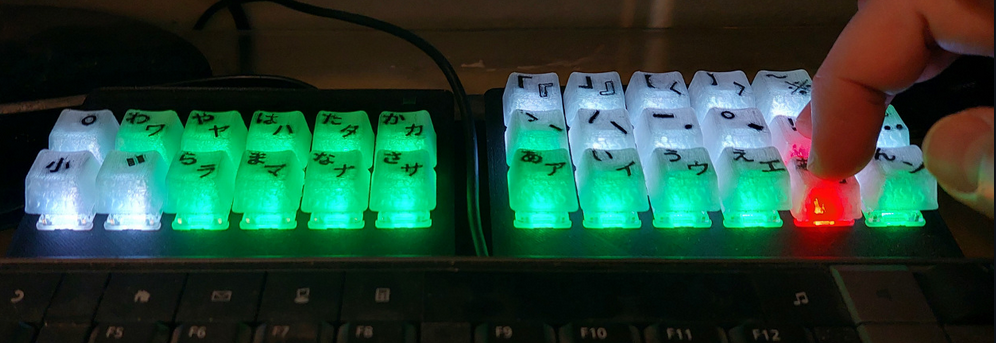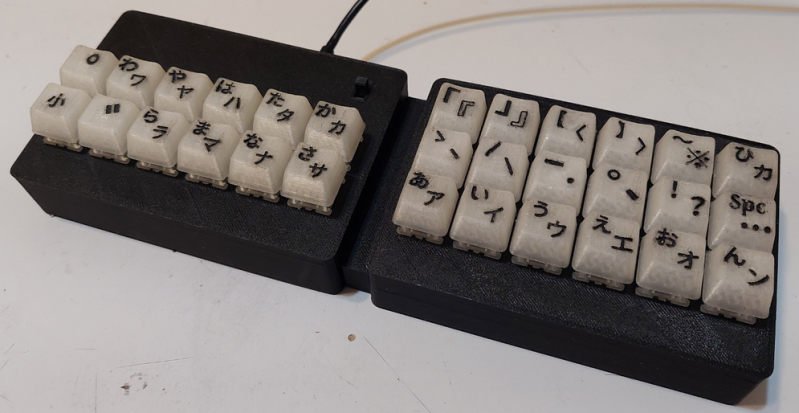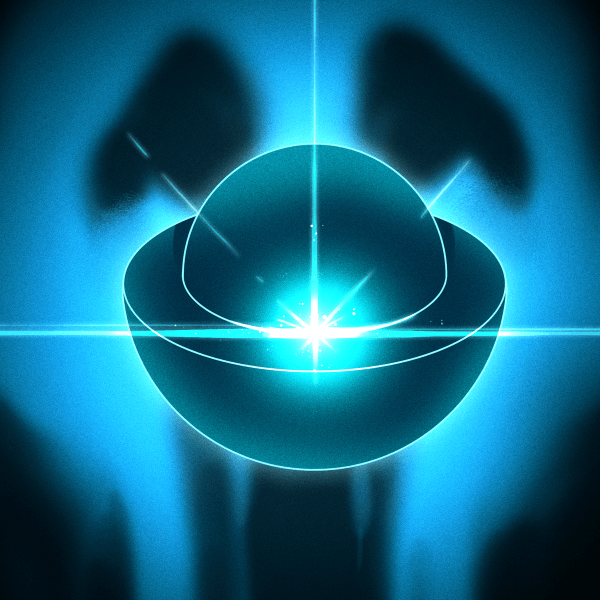There are various situations that warrant additional keyboards on your desk, and inputting a second language is definitely a good one. That’s the idea behind KanaChord, which generates Unicode macros to render Japanese Kana characters using chords — pressing multiple keys at once as you would on a piano.
The Japanese writing system is made up of Kanji (Chinese characters), Hirigana, and Katakana. Without going into it too much, just know that Hirigana and Katakana are collectively known as the Kana, and there’s a table that lays out the pairing of vowels and consonants. To [Mac Cody], the layout of the Kana table inspired this chording keyboard.
One of the great features of KanaChord is that it uses color to indicate character type, Kana mode, and even provide error feedback. Another is the slide switch that selects one of three Unicode key sequences in order to support different computer platforms.

The brains of this operation is a Raspberry Pi Pico, an extremely popular choice for keyboards. [Mac Cody] used an Adafruit NeoKey 5×6 Ortho Snap-Apart keyboard PCB to make things easy, plus thirty Cherry MX switches of unknown color. The enclosure and the keycaps are 3D printed. There’s a wonderful amount of detail in the hardware section of the repo, so dig in.
Right now, KanaChord only outputs Kana Unicode and not Kanji Unicode, which gives an incomplete input system for Japanese as-is. Don’t worry — [Mac] is working on the KanaChord Plus Keyboard, which will also output Kanji Unicode for over 6,000 commonly-used Kanji.

















As Japanese would say: SUGO!
Do you mean sugoi 【すごい】, i.e., amazing? If so, arigatou gozaimasu! 【ありがとうございます!】, i.e., thank you!
You are going to have fun when you find out that native speakers mispronounce almost every word in every possible way in normal speech. There are literally people that shorten thank you to あざす. すご is probably some people genuinely use although I’m sure it’s a mistake here.
すごい! actually becomes すげ! in more informal settings.
A: すごい、日本語が上手ですね!
B: いえいえ、日本語は難しい。。。かなでがんばりま。💪
>すごい! actually becomes すげ! in more informal settings.
Sure it can but native speakers create random mispronunciations on a daily basis with lots of regional and generational differences. Also the mispronunciation can be either a stylistic thing or an intention thing. Many “i adjectives” can have the final syllable replaced with an え sound, the final い dropped or whatever is cool on that day of the week with the young people.
For example:
やばい
あいつの日本語やべぇぞ、まったく意味わからん。
or
やば! すぐトイレに行かなきゃ!漏れちゃう!
The point seems to be for learning kana but it’s basically useless. Learning kana takes about a week with flashcards. You need an IME to actually write in Japanese and almost everyone uses romaji based input which requires you to learn kana eitherway… So why bother with a weird keyboard that’ll need a weird niche IME?
The reason most people on here do most things, for the hell of it.
The point is not to learn the Kana but to be able to type the Kana.
Referencing ‘How to Type Japanese’ (https://www.coscom.co.jp/learnjapanese801/howjpdo.html):
– The reason most Japanese use romaji is because it is difficult to remember the locations of the Kana keys on the keyboard, not to mention switching the keyboard mode back and forth between Kana and Latin characters.
– As a consequence of typing in romaji, more keys have to be typed to obtain a Kana or Kanji character.
– IMEs (Input Method Editors) can take input in either romaji or Kana and are available for MS Windows, MacOS, and Linux.
When learning Japanese, it is generally considered better to learn the Kana directly and not use romaji, as doing so will make it more difficult to properly pronounce and read Japanese. When learning to read in Japanese, it is often recommended to use graded readers (see https://tadoku.org/japanese/en/graded-readers-en/). Introductory graded readers either only use the Kana, with added spacing to delineate words, and no Kanji, or provide Kanji with furigana (Kana characters over the Kanji, to aid in pronunciation). While there are many source available for input of Japanese for the learner, generating output by the learner, especially writing, is a bit more challenging. KanaChord makes typing Kana easier, because the chording process naturally reflects the Kana table.
Once KanaChord Plus is completed, installation of an IME will not be necessary, as the Kanji Unicode can be input, as well as the Kana Unicode. KanaChord Plus will have an ‘incremental’ IME through which the user types Kana characters and is presented a list of candidate Kanji to choose from. This will encourage the user to learn the different readings (Kana pronunciations) of Kanji characters as Japanese words and phrases are constructed.
>not to mention switching the keyboard mode back and forth between
>Kana and Latin characters.
Japanese keyboards have control keys for controlling the IME.
>As a consequence of typing in romaji, more keys have to be typed to obtain
>a Kana or Kanji character.
The longest kana is 3 keys in romaji. If you use the direct input modes and use the hiragana symbols you still need multiple key presses to get some kana. It’s barely different and most people that use a computer need to be about to enter Japanese and at least words in romaji (i.e. urls for sites) so you might as well use romaji input and that’s what most people do.
Also, you barely ever enter the whole sequence of kana or a single kanji. You start entering the word or sentence you want to write and the IME/text input will be autocompleting for you.
>When learning Japanese, it is generally considered better to learn the Kana
>directly and not use romaji, as doing so will make it more difficult to properly
>pronounce and read Japanese.
Yet my Japanese kids at school in Japan that only understand Japanese are taught how to use romaji barely after learning hiragana so they can operate a keyboard…
this version are better https://klawiatura.wordpress.com/wp-content/uploads/2010/08/keyb-ja0.png
Looks like a keyboard for the polydactyl.
Please explain why it is better. The user would have to memorize the key locations for each Kana (48 keys!) along with the Latin characters. They would also have to switch between Kana and Latin character mappings as needed. I know that there must be a reason for the placing of the Kana characters on the keyboard, as it appears to follow some standard. I don’t know what that is, though.
Keep working on your project, eff the haters!